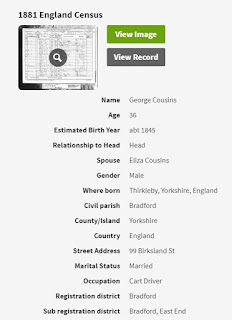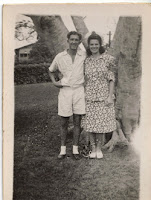52 ancestors Week 50 (Dec. 9-15): Witness to History
Week 50 (Dec. 9-15): Witness to History
From Amy Johnson-Crow - It's important to put our
ancestors in context with their time and surroundings. What would your ancestor
have witnessed? I encourage you to think beyond the "big events." I
think about my farming ancestors and the changes they would have seen in
equipment and getting their crops to market.
For this weeks theme of “witness to history” the 1st
person that came to my mind was a gentleman called “Abner Haylock”. His story
is a rags to riches tale and one him and his family would not have had or seen
had they not left the UK!
Abner is my 2nd cousin 4x removed in my maternal lineage, my Mum was born a Haylock. He was born in 1844 in Great Thurlow, Suffolk to John Haylock and Ann Guymer, he was 1 of 13 children known, some people have 11 others have 16.
This photo of Abner (left) to me screams wealth and good fortune.
Abner’s father was an Ag-lab on the farms of Suffolk, he didn’t have his
own farm as far as I know. So this means that the family weren’t very well off.
I am guessing that they had to save a lot of money (that they didn’t have) to
make the move to Australia in 1852. They travelled on the “omega ship” from
Plymouth to Adelaide, Australia.
This time frame was early in the “Gold Rush” of Australia, and my ancestors
moved there for it, and they certainly made the right choice! They left UK with
nothing, but after many years of hard work the family were very well off.
Abners parents had made their way onto the goldfields of Victoria by
purchasing a 96 acre allotment, adjoining the village of Kingston, east of
Ballarat. Both John and Ann died in the mid 1860’s and the family went their
various ways.
Abner went into the carrying business and married in Campbelltown in 1867. In 1878 Abner had become that successful that he was able to go up into the Riverina and he bought land at Gunbar (between Hay and Griffith), he called this property “Kingston Park and it ended up as 16,000 acres which was sold after his death in 1920.
During the great drought of 1902 he bought ‘Coonerang’ near Cooma as relief country, which his eldest son Arthur ran before and after his father’s death, increasing the acreage over the years. Arthur’s brothers bought other land in the area.Had the family not left Suffolk they would never have become a “witness
to history” linked to the Gold Rush.
I had further success in tracing the family in Australia when I found more information and photographs on the Monaro Pioneers website.





THE ABOVE POST SHOULD READ AS FOLLOWS:
ReplyDeleteWeek 50 (Dec. 9-15): Witness to History
From Amy Johnson-Crow - It's important to put our ancestors in context with their time and surroundings. What would your ancestor have witnessed? I encourage you to think beyond the "big events." I think about my farming ancestors and the changes they would have seen in equipment and getting their crops to market.
For this weeks theme of “witness to history” the 1st person that came to my mind was a gentleman called “Abner Haylock”. His story is a rags to riches tale and one him and his family would not have had or seen had they not left the UK!
Abner is my 2nd cousin 4x removed in my maternal lineage, my Mum was born a Haylock. He was born in 1844 in Great Thurlow, Suffolk to John Haylock and Ann Guymer, he was 1 of 13 children known, some people have 11 others have 16.
Abner’s father was an Ag-lab on the farms of Suffolk, he didn’t have his own farm as far as I know. So this means that the family weren’t very well off. I am guessing that they had to save a lot of money (that they didn’t have) to make the move to Australia in 1852. They travelled on the “omega ship” from Plymouth to Adelaide, Australia.
This time frame was early in the “Gold Rush” of Australia, and my ancestors moved there for it, and they certainly made the right choice! They left UK with nothing, but after many years of hard work the family were very well off.
Abners parents had made their way onto the goldfields of Victoria by purchasing a 96 acre allotment, adjoining the village of Kingston, east of Ballarat. Both John and Ann died in the mid 1860’s and the family went their various ways.
Abner went into the carrying business and married in Campbelltown in 1867. In 1878 Abner had become that successful that he was able to go up into the Riverina and he bought land at Gunbar (between Hay and Griffith), he called this property “Kingston Park and it ended up as 16,000 acres which was sold after his death in 1920.
During the great drought of 1902 he bought ‘Coonerang’ near Cooma as relief country, which his eldest son Arthur ran before and after his father’s death, increasing the acreage over the years. Arthur’s brothers bought other land in the area.
Had the family not left Suffolk they would never have become a “witness to history” linked to the Gold Rush.